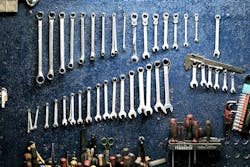2016 Aftermarket Outlook
“2015 turned out to be pretty darn good,” said David Portalatin, executive director of Industry Analysis for The NPD Group, Inc. Every year, National Oil & Lube News heads to Vegas for the AAPEX show and every year we make sure not to miss the Aftermarket Outlook educational session. In this session, as the name would suggest, experts predict trends for the New Year. This year was no different.
“Let me begin by taking a little trip down memory lane and looking back on 2015,” Portalatin said. “I’ll hold myself accountable to what I said in this very same spot last year and let you know how right or wrong I was in predicting some of the underlying trends that may or may not have occurred.”
At the 2014 AAPEX show, Portalatin said there would be three primary things affecting sales growth, the demand for automotive products and the automotive aftermarket in general. Those three things were miles driven, total cars on the roadways and how people used their cars the most.
“In reality, the two factors that changed the most were actual miles driven and retail sales price. Miles driven exceeded expectations in 2015 while retail sales increased by 4.4 percent. Through January, 2015, to September, 2015, Americans consumed 4 percent more gasoline than they did in 2014 but they spent $87 billion less for it.”
Consumers across the U.S. have appreciated the drop in fuel prices but Portalatin raised the question everyone was wondering, what are they doing with the extra money?
“The retail figures show there’s not a lot of growth in consumer spending overall — that includes fashion, food, entertainment etc. In fact, consumer spending has only grown about 2 percent. This means something different is going on in the automotive aftermarket space,” Portalatin said. “Consumers are holding onto their money right now. Only time will tell if they’ll get any freer with their spending but for now, they’re holding onto it unless, however, they’re investing it into their vehicles because they see valuable ROI there.”
Portalatin continued by making his predictions for 2016.
“In 2014 miles driven increased 1.8 percent. Based upon our updated forecasting, by the end of 2015 the increase in miles driven will be 3.3 percent more than it was over a year ago,” Portalatin said. “Our forecast for 2016 includes miles driven continuing to increase but only by about 2 percent. That’s not as much as last year but it’s still good.”
Portalatin suggested one reason miles driven are not predicted to be as robust in 2016 as they have been in previous years is because of millennials.
“Millennials are not kids anymore. Millennials are moving into career and family life stages — peak driving years. They are working close to home or at home and are using alternative forms of transportation like biking, walking and carpooling. Their overall capacity for generating miles is at a whole different level than previous generations,” Portalatin said.
However, millennials aren’t the only generation to blame for the decrease in mileage creation. The amount of new drivers on the road is a consumer trend that may have longer lasting effects. Chances are, at the age of 15, you were probably itching to get your license. If you didn’t get it on your 16th birthday, you probably got it the day after. Today, studies show not all teenagers are as eager to head out and get their drivers licenses. Some researchers attribute this to a hyper-connected world comprised of social media, text messaging and teens whom no longer have a need to get in the car to go see their friends. After all, they can just look on the plethora of social media platforms available today. Other researchers attribute the trend to a more environmentally aware generation than generations past. Either way, times are changing and generational change is a long-term conversation.
“We did some research awhile back that suggested about 30 percent of today’s 16- year-olds have a drivers license. I’ve seen other studies say that number is somewhere around 40 percent. Regardless of what the number is, it’s crystal clear today’s generation is not as engaged with vehicles and driving as past generations,” Portalatin said.
Portalatin predicted retail sales would do very well and grow from $14.7 billion in 2015 to $15.1 billion in 2016, opening up a large margin or overall industry growth. Portalatin attributes this to yet another interesting consumer behavior.
“Consumers are continuing to seek out value. They aren’t just choosing the lowest price. In fact, they are doing the opposite. They’re choosing the higher priced items because they believe these products offer them more ROI. This isn’t to say price isn’t important to consumers, it certainly is,” Portalatin said. “71 percent of consumers say a reasonable price is an important attribute in deciding what automotive products they buy. However, the next three most important deciding factors consumers consider before purchasing a product are, ‘Is it made with quality materials, does it increase gas mileage and does it increase engine performance?’ There’s momentum behind these things in the marketplace. Look for ways to create value for your customers and include these attributes. When it comes to automotive products it’s not always about being the cheapest. There is a lot of weight behind products that fall on the higher quality end of the spectrum so it’s no surprise this trend is working out very nicely in the retail sales data.”
Indeed, 2015 was “pretty darn good” but 2016 looks like it will be too. Sure, the industry faces some challenges and will need to adapt to generational changes but any industry that has the potential to grow in the double digits for 2016, as Portalatin suggested, certainly, has a bright future.
